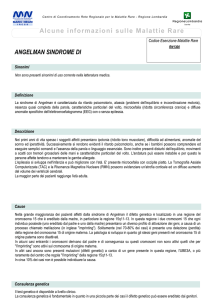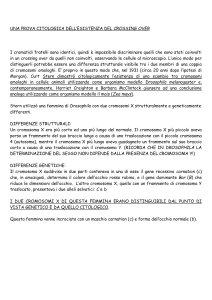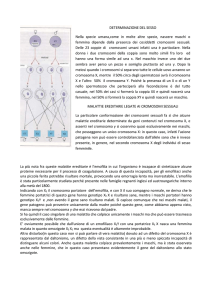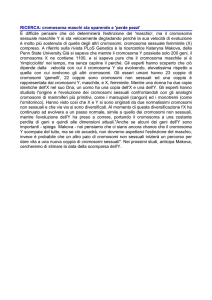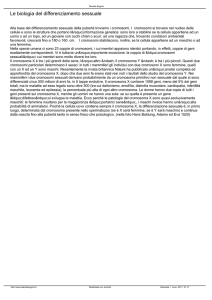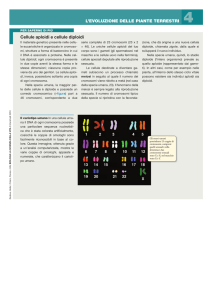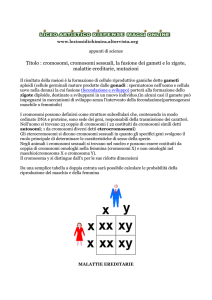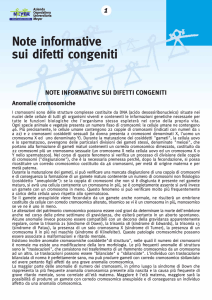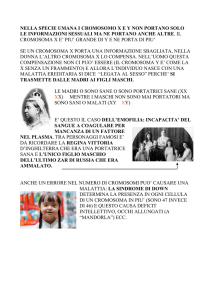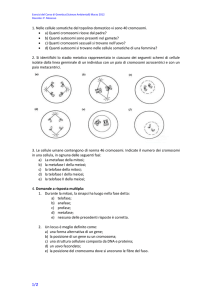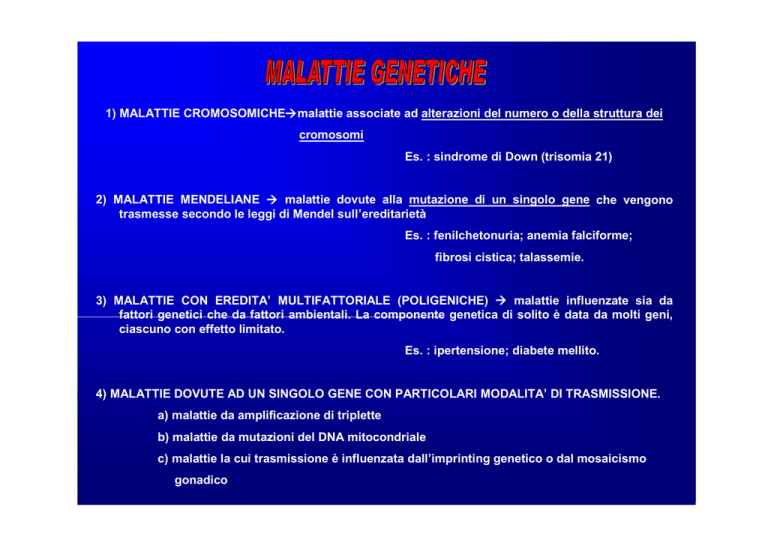
1) MALATTIE CROMOSOMICHEÆmalattie associate ad alterazioni del numero o della struttura dei
cromosomi
Es. : sindrome di Down (trisomia 21)
2) MALATTIE MENDELIANE Æ malattie dovute alla mutazione di un singolo gene che vengono
trasmesse secondo le leggi di Mendel sull’ereditarietà
Es. : fenilchetonuria; anemia falciforme;
fibrosi cistica; talassemie.
3) MALATTIE CON EREDITA’ MULTIFATTORIALE (POLIGENICHE) Æ malattie influenzate sia da
fattori genetici che da fattori ambientali. La componente genetica di solito è data da molti geni,
ciascuno con effetto limitato.
Es. : ipertensione; diabete mellito.
4) MALATTIE DOVUTE AD UN SINGOLO GENE CON PARTICOLARI MODALITA’ DI TRASMISSIONE.
a) malattie da amplificazione di triplette
b) malattie da mutazioni del DNA mitocondriale
c) malattie la cui trasmissione è influenzata dall’imprinting genetico o dal mosaicismo
gonadico
www.fisiokinesiterapia.biz
a computer-assisted assembly of a karyotype from a female (46, XX)
metaphase and prometaphase G-banded human chromosome 1 and the standard nomenclature for labeling the
bands;
short arm: p (petite); long arm: q;
1 - 4 regions for each arm labeled from centromere towards telomere
each region has several bands, again numbered away from the centromere
Numero cromosomi
assetto cromosomi sessuali
47, XY, +21
eventuali anomalie
p (da petit) Æ braccio corto del cromosoma
q Æ braccio lungo del cromosoma
Xp21.2 = cromosoma X, braccio corto, regione 2, banda 1, sottobanda 2
The probe molecule is labelled with a hapten such as biotin. The biotin is
located with streptavidin. The streptavidin is located with antibodies. A
fluorescent dye may be conjugated to the streptavidin and to the antibodies.
When the spread chromosomes are illuminated by a UV lamp, a point of
fluorescence can be seen where the probe/streptavidin/antibody/fluorescent
dye multilayer sandwich has built up. From three to five layers of fluorescent
antibodies are built up to amplify the signal.
•Cytogenetic mapping by FISH
A probe is made from a genomic (or sometimes even
a cDNA) clone by using the Nick Translation reaction
to incorporate a biotinylated nucleotide into DNA.
Metaphase chromosome spreads are made by
conventional techniques, the spread chromosomes are
treated to denature the DNA of the chromosomes and
the probe is allowed to hybridise to the chromosomes.
Later, the site(s) of hybridisation is found by using
streptavidin and antibodies conjugated to a fluorescent
dye. In this way the site of origin of any clone can be
found in the genome.
Here is one example from the Wisconsin site which
shows a cosmid hybridising specifically to a site on
chromosome 13. Remember that the chromosomes are
replicated ready to divide and that each therefore
consists of two chromatids. The probe has hybridised
to all four chromatids.
a metaphase spread of human chromosomes
Chromosome painting with specific probes (1990s) (from MetaSystems)
This methodology is based on in situ hybridization of probes to metaphase chromosomes;
different probes can be conjugated to different fluorescent chromophores;
Whole chromosomes, individual bands of a specific chromosome, or even single genes can be
detected.
Esiste un’importante correlazione positiva fra età della madre (ma
non del padre) e probabilità di avere un figlio affetto da sindrome
di Down Æ il fenomeno della non disgiunzione meiotica si
verifica più frequentemente durante la gametogenesi femminile.
La non disgiunzione dei cromosomi 21 può anche verificarsi
durante la divisione mitotica. Se questo avviene durante le prime
divisioni cellulari dello zigote si può avere la formazione di un
individuo con MOSAICISMO cromosomico.
L a s in d ro m e d i D o w n p u ò a n c h e e s s e re il ris u lta to
tra s lo c a z io n e fra il c ro m o s o m a 2 1 e il c ro m o s o m a 1 4 .
di
una
Robertsonian translocations involve two acrocentric chromosomes that fuse near the
centromere region with loss of the short arms. The resulting karyotype has only 45
chromosomes since two chromosomes have fused together. The most common translocation
involving chromosomes 13 and 14 is seen in about 1 in 1300 persons, making it the most
common chromosome rearrangement in humans. Like most other translocations, carriers of
Robertsonian translocations are phenotypically normal.
QUADRO CLINICO SINDROME DI DOWN
• Ritardo mentale
• Bassa statura
• Faccia appiattita; pliche palpebrali; orecchie malformate;
macroglossia; denti irregolari
• Mani e piedi tozzi, con peculiari impronte palmari e dermatoglifi
e anomalo spazio tra alluce e secondo dito
• Malformazioni cardiache; stenosi intestinale; ipotonia muscolare
• Sterilita’
• Rischio sviluppo leucemia
MALATTIE CITOGENETICHE DA ALTERAZIONI DEI
CROMOSOMI SESSUALI
Sono molto più frequenti di quelle dovute ad alterazioni degli autosomi (= sono
più tollerate)
Motivi:
- Inattivazione di tutti i cromosomi X tranne uno (ipotesi di M. Lyon) [cromosoma X
inattivato Æ corpo di Barr]
- Piccola quantità di materiale genetico sul cromosoma Y
Caratteristiche generali:
- IN GENERALE CAUSANO PROBLEMI LIEVI E CRONICI CORRELATI CON LO
SVILUPPO SESSUALE E LA FERTILITA’
- SPESSO E’ MOLTO DIFFICILE FARE UNA DIAGNOSI ALLA NASCITA, IN
MOLTI CASI E’ POSSIBILE SOLO AL MOMENTO DELLA PUBERTA’
- IN GENERALE, SIA NEI MASCHI CHE NELLE FEMMINE, PIU’ ALTO E’ IL
NUMERO DELLE X MAGGIORE E’ LA PROBABILITA’ CHE SI ABBIA RITARDO
MENTALE
SINDROME DI TURNER (45, X0)
Sindrome di Turner con cromosoma X ad anello: 46, X, r(X)
Supposte correlazioni tra Xp e fenotipo nella sindrome di Turner (TS)
POF = premature ovarian failure
SINDROME DI KLINEFELTER (47, XXY)
LA SINDROME DI KLINEFELTER
(47, XXY)
Testicular biopsy from an adult male with body habitus suggestive of
Klinefelter’s syndrome. The biopsy shows small hyalinized seminiferous
tubules and pseudo-adenomatous clusters of Leydig cells.
TRISOMIA X (47, XXX)
Si possono distinguere due tipi principali di aberrazioni cromosomiche:
- Variazioni del numero dei cromosomi Æ ANEUPLOIDIE
-
ALTERAZIONI STRUTTURALI
a) Delezione Æ perdita di una parte del cromosoma osservabile all’esame microscopico
b) Duplicazione Æ ripetizione di una parte del cromosoma nel suo stesso contesto
c) Inversione Æ il frammento centrale risultante da due rotture di un cromosoma ruota di
180° e si inserisce tra gli altri due frammenti ricostituendo l’integrità morfologica di
esso ma con sequenza genica modificata
d) Traslocazione Æ inserimento su di un cromosoma diverso di un pezzo di un
cromosoma staccatosi dal cromosoma di appartenenza (t. semplice) o scambio fra
due cromosomi non omologhi di frammenti cromosomici formatisi per rottura (t.
doppia)
POLIPLOIDIA Æ numero di cromosomi multiplo di quello normale
DELEZIONE BRACCIO LUNGO CR. 12
DELEZIONE
DUPLICAZIONE
INVERSIONE
TRASLOCAZIONE


